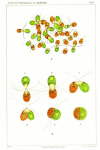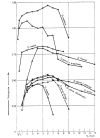A hundred years of Dunaliella research: 1905-2005
- PMID: 16176593
- PMCID: PMC1224875
- DOI: 10.1186/1746-1448-1-2
A hundred years of Dunaliella research: 1905-2005
Abstract
A hundred years have passed since the description of the genus Dunaliella, the unicellular green alga which is responsible for most of the primary production in hypersaline environments worldwide. The present paper provides an historical survey of research on Dunaliella, from the early work in the 19th century to the thorough taxonomic studies by Teodoresco, Hamburger, Lerche and others from the beginning of the 20th century onwards. It attempts to trace the origin of some of the most important breakthroughs that have contributed to our present understanding of this alga that plays such a key role in many hypersaline environments.
Figures





Similar articles
-
The ecology of Dunaliella in high-salt environments.J Biol Res (Thessalon). 2014 Dec 18;21(1):23. doi: 10.1186/s40709-014-0023-y. eCollection 2014 Dec. J Biol Res (Thessalon). 2014. PMID: 25984505 Free PMC article. Review.
-
Identification and characterization of a new strain of the unicellular green alga Dunaliella salina (Teod.) from Korea.J Microbiol Biotechnol. 2008 May;18(5):821-7. J Microbiol Biotechnol. 2008. PMID: 18633277
-
Glycerol metabolism in hypersaline environments.Environ Microbiol. 2017 Mar;19(3):851-863. doi: 10.1111/1462-2920.13493. Epub 2016 Aug 25. Environ Microbiol. 2017. PMID: 27511298 Review.
-
Clara Hamburger and Dunaliella salina Teodoresco - a Case Study from the First Half of the XXth Century.Protist. 1998 Dec;149(4):381-8. doi: 10.1016/S1434-4610(98)70044-6. Epub 2009 Jul 13. Protist. 1998. PMID: 23194720 No abstract available.
-
Chapter 33: the history of movement disorders.Handb Clin Neurol. 2010;95:501-46. doi: 10.1016/S0072-9752(08)02133-7. Handb Clin Neurol. 2010. PMID: 19892136 Review.
Cited by
-
Massive and widespread organelle genomic expansion in the green algal genus Dunaliella.Genome Biol Evol. 2015 Feb 6;7(3):656-63. doi: 10.1093/gbe/evv027. Genome Biol Evol. 2015. PMID: 25663488 Free PMC article.
-
The ecology of Dunaliella in high-salt environments.J Biol Res (Thessalon). 2014 Dec 18;21(1):23. doi: 10.1186/s40709-014-0023-y. eCollection 2014 Dec. J Biol Res (Thessalon). 2014. PMID: 25984505 Free PMC article. Review.
-
DsHsp90 is involved in the early response of Dunaliella salina to environmental stress.Int J Mol Sci. 2012;13(7):7963-7979. doi: 10.3390/ijms13077963. Epub 2012 Jun 27. Int J Mol Sci. 2012. PMID: 22942684 Free PMC article.
-
Introduction of a novel 18S rDNA gene arrangement along with distinct ITS region in the saline water microalga Dunaliella.Saline Syst. 2010 Apr 8;6:4. doi: 10.1186/1746-1448-6-4. Saline Syst. 2010. PMID: 20377865 Free PMC article.
-
Production of Secondary Metabolites in Extreme Environments: Food- and Airborne Wallemia spp. Produce Toxic Metabolites at Hypersaline Conditions.PLoS One. 2016 Dec 30;11(12):e0169116. doi: 10.1371/journal.pone.0169116. eCollection 2016. PLoS One. 2016. PMID: 28036382 Free PMC article.
References
-
- Dunal F. Extrait d'un mémoire sur les algues qui colorent en rouge certains eaux des marais salants méditerranéens. Ann Sc Nat Bot 2 Sér. 1838;9:172.
-
- Teodoresco EC. Organisation et développement du Dunaliella, nouveau genre de Volvocacée-Polyblepharidée. Beih z Bot Centralbl. 1905;Bd. XVIII:215–232.
-
- Ginzburg M. Dunaliella : a green alga adapted to salt. Adv Bot Res. 1987;14:93–183.
-
- Avron M, Ben-Amotz A, Ed. Dunaliella: Physiology, Biochemistry, and Biotechnology. Boca Raton: CRC Press; 1992.
-
- Oren A. Halophilic Microorganisms and their Environments. Dordrecht: Kluwer Academic Publishers; 2002.
LinkOut - more resources
Full Text Sources
Other Literature Sources

